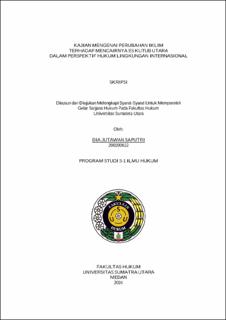| dc.description.abstract | Climate change has become a global problem that has inevitable impacts at regional and international levels. Rising sea levels, melting polar ice, and economic losses in the Pacific region. The commitment of world citizens to collaborate to reduce greenhouse gas production and overcome the impacts of climate change can be seen from several international instruments related to this matter which have gradually been successful. However, legislation written to specifically protect mountain glaciers has only recently been considered on the national political agenda. The main problem in this thesis entitled "Study of Climate Change and Melting Ice in the North Pole in the Perspective of International Environmental Law" is how international environmental law is regulated in dealing with climate change regarding the melting of ice in the North Pole, what is the role of the United Nations Framework Convention on Climate Change (UNFCCC) in terms of taking policies (Policy making) to overcome climate change, and how to implement the Glacier Protection Law as an effort to prevent the melting of glaciers and ice in the North Pole. This thesis uses a juridical research method, the data used is secondary data, and the data that has been collected is analyzed using qualitative methods to answer the problems in this thesis.
It can be concluded that (1) international environmental law has similarities regarding its legal objects. The dynamic objects of international law may be changed and adapted to global conditions. The sources of international environmental law are listed in Article 38 of the statute of the International Court of Justice; (2) The UNFCCC has succeeded in forming protocols and agreements which are an integral part of the UNFCCC, namely the 1997 Kyoto Protocol and the 2015 Paris Agreement. The UNFCCC in addressing climate change uses the Principle of Common but Differentiated Responsibilities. This principle stipulates that shared responsibility does not necessarily result in equal obligations, but guarantees the participation of all states in international environmental law; and
(3) laws to protect periglacial landscapes and environments were enacted in Argentina and similar laws have been discussed in the parliaments of Chile and Kyrgyzstan. The GPL is largely designed to protect the environment from fishing and other natural resource extraction activities that have the potential to destroy ecosystems, pollute air supplies, threaten the cultural values of mountainous areas, hinder tourism, and damage the aesthetic appeal of high mountain landscapes. | en_US |


